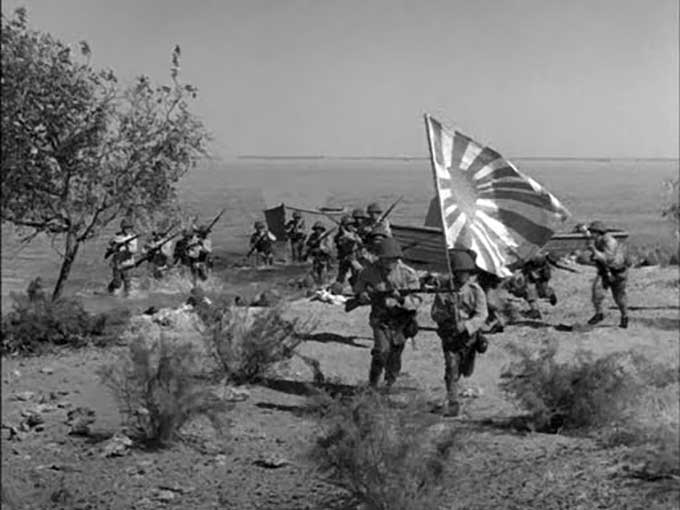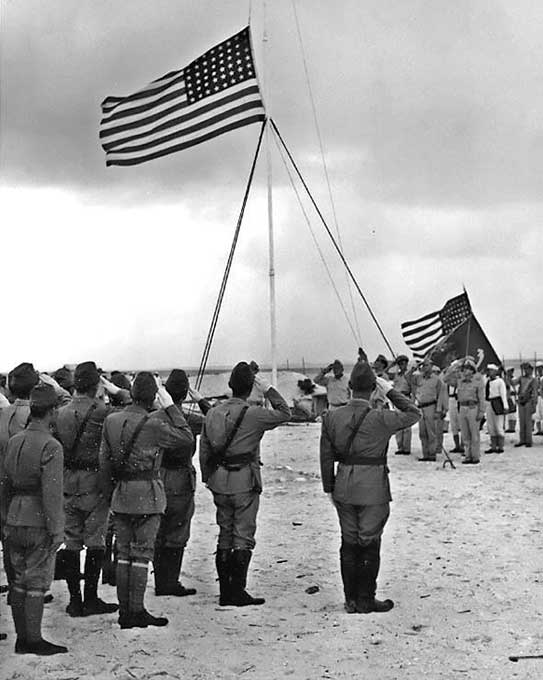News of the December 7, 1941 horrific Japanese attack against Pearl Harbor quickly captured the attention of Americans and the world. But very few are aware that just hours after Pearl Harbor, Japan also attacked strategically located Wake Island where the US had over a thousand contractors building a Navy-Marine base and an airstrip. Although the attack is recorded as December 8, it was on the same day as Pearl because Wake is located on the other side of the International Date Line. Located about halfway between Midway and Guam in the South Pacific, Wake is a rectangular shaped atoll, with an open lagoon on one side, consisting of the three islets of Wilkes, Peal and Wake. Surrounded by coral reef, the total atoll area is about two and half miles.

Wake defense forces were gradually being built up. On Nov 3, 15 officers and 373 enlisted Marines arrived. They were joined by nine naval officers and 58 sailors, arriving on a seaplane tender on Nov 28. The next day a Marine detachment arrived to set up air base communication facilities. That was followed on December 4 with a squadron of 12 FAF-3 Marine Fighter aircraft including pilots and support personnel, delivered from aircraft carrier USS Enterprise. The planes began daily patrols but Japanese aircraft scouted the atoll undetected.
First Invasion Force
Wake air defense forces included a few anti-aircraft guns and stationary naval batteries, in addition to the 12 Wildcat fighters. Total military personnel included 449 Marines, including 55 from the air detachment. There were also 68 Navy and five Army personnel. When notified by military radio about Pearl, US. Forces went “on alert”. No one there knew that an Japanese invasion fleet of three light cruisers, six destroyers, two patrol boats and two troop transports with 450 Special Naval Landing Force troops was closing in nor that Japanese aircraft were rapidly approaching from the Marshall Islands in advance of the ships. Heavy pounding of waves against the reefs prevented hearing approaching enemy planes until they were overhead. Seven F4F fighters were destroyed on the runway before able to take off. But the naval batteries sank one destroyer and damaged several other ships including the flagship Yubari. US aircraft sank another destroyer, the first Japanese ships sunk in the Pacific War. The landing attempt was driven off by the remaining Wildcat fighters and marine beach defenses. The Japanese Navy withdrew back to their Marshalls Island base but continued sending reconnaissance flying boats on bombing missions.
Second Invasion Force
The Japanese returned with a much larger invasion force. It included two aircraft carriers, and was also reinforced by heavy cruisers and destroyers returning from the Pearl Harbor attack. Large numbers of aircraft carrier and land based planes came ahead on bombing raids in several days in advance, with fighters planes knocking out the last two Marine Wildcats in aerial combat. On Dec 23, 1,500 Special Troops landed with another 1,000 available for a second assault. Those entire enemy forces against 520 US military personnel, with damaged shore batteries and no planes. Knowing defeat was imminent, a US task force from Pearl, several days away, with the aircraft carrier Saratoga was recalled. A few days earlier, all US subs had been ordered out of the area.. Although many of the Americans wanted to continue fighting, the senior officers ordered surrender because their defense capabilities were severely limited. The statistics showed that the Japanese suffered 820 killed and 333 wounded, with several ships and submarines sunk. US forces had 120 killed, 49 wounded, 2 missing in action; with 433 Military and 1,104 civilian POWs.
Ninety Eight of the contractors were kept on Wake to do specialized construction work. But after an attack by allied forces, the Base Commander had all of them executed, concerned that they might arise as a “fifth Column” during a future attack. One survived and wrote the number 98 as a memorial on a huge boulder near the mass killings. He was captured the next day and beheaded. The Japanese Commander was hanged after the war for killing the POWs. Wake remained under Japanese control until after the Japanese WWII surrender on Sept 2, 1945, turning Wake over to allies two days later, Sept 4, 1945.
Background
Wake occupation was part of Japan’s “Outline Plan for the Execution of the Empire’s National Policy”. This plan was to expand Japanese outer perimeters so far that enemies could not attack the Home Islands nor the soon to be newly acquired islands containing vital valuable natural resources, including desperately needed oil and rubber. This perimeter extended from the Kurile Islands down to Wake, Guam, Dutch East Indies, British Malaya and up to Burma. Japanese planners figured they needed six months for this expansion and the U.S. recovery from Pearl Harbor provided that time.
Earlier, in September 1940, Germany, Italy and Japan had allied under the Tripartite Pact. The US banned shipping gasoline to Japan in July 1940 and by 1941, shipments of scrap iron, steel, gasoline and other materials had almost stopped. Japan and the USSR signed a neutrality pact in April, 1941 and Japan increased pressure on and French and Dutch colonies in SE Asia to cooperate in economic matters. Then Japanese forces occupied the naval and air bases of Southern Indochina on July 22, 1941. The Philippine Islands, British Malaya and Guam in Mariana Islands were next in their sights.
Breaking the Japanese military codes by November, 1942 changed our defensive posture; enabling allies to track enemy shipping and other military activity; directing Allied submarines to successfully attack convoys and ships. This intelligence gathering was responsible for the successful American ambush of the Japanese Navy at Battle of Midway which was considered the turning point in the war. It also enabled our planes to shoot down Japan’s military genius, Admiral Yamamoto, while he was airborne, helping shorten the war.
Despite numerous attacks, Allied forces did not retake Wake. Japan loaded it with troops and defensive weaponry. With military codes broken, our subs had info to cut off supply ships. Over a thousand troops starved to death there before war ended.

Wildcat shot down after sinking Japanese Destroyer. 
Japanese assault landing portrayed in 1942 movie “Wake Island” had defenders fight to last man 
Admiral Shigematsu Sakaibara signing Wake surrender aboard USS Levy on Sept 4, 1945. 
Japanese destroyer Hayate, sunk at Wake. 
A destroyed Japanese patrol boat (#33) on Wake. 
Formal Sept 4, 1945 Japanese surrender of the Japanese on Wake Island. Admiral Shigematsu Sakaibara is Japanese officer on right forefront.




















